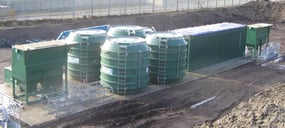We’re on LinkedIn!
Connect with WCS Environmental Engineering Safe Efficient Compliance

The above ground units were purchased by the contractor Natta Building Company for the 2000 temporary workers/staff due to a lengthy construction period; the portable units provided a complete wastewater treatment process capable of achieving the following consent standard:
The raw sewage influent will be pumped to the inlet of the lamella plate primary settlement tank (LPPST) where it is anticipated 30% of the BOD load will settle out. After primary settlement the outlet flow will leave the LPPST via multiple outlet connections which effectively split the flow into equal streams. The LPPST is equipped with baffles to prevent any floating scum entering the biological phase of the treatment. Sludge is periodically transferred to a separate sludge storage tank utilising an actuated valve on the sludge outlet point.
After primary settlement the flows will split (under full loading conditions) and flow under gravity to one of the SAF bio-treatment streams consisting of multiple T300 SAF biological treatment tanks, and the two streams re-combine to flow into one single T750 unit. These tanks are of the submerged bed aerated filter type (SAF) and are each split into several chambers each filled with high voidage plastic media. Whilst passing through these chambers both carbonaceous and nitrifying processes take place. Air to oxidise the influent and to scour excess biomass from the filter media is introduced continuously below each chamber by a series of diffusers. Each diffuser is capable of being removed for maintenance without the necessity to shut down the plant.
With nutrient neutrality requirements being enforced at off-mains properties in areas of England, homeowners need to ...
Why managing variable loads matters If you have an off mains wastewater treatment system operating at a hospitality, ...
Trade effluents are liquid waste streams discharged into public sewers from businesses and industrial processes. Their ...
Connect with WCS Environmental Engineering Safe Efficient Compliance
WCS Group is a trading name for WCS Environmental Ltd, registered in England and Wales (Number 02184649) at 20 Grosvenor Place, London, SW1X 7HN. Head Office – 17 Wheatstone Court, Waterwells Business Park, Gloucester, GL2 2AQ. WCS Group is a Marlowe Critical Services Company owned by Marlowe plc. 2025© WCS Environmental Ltd.